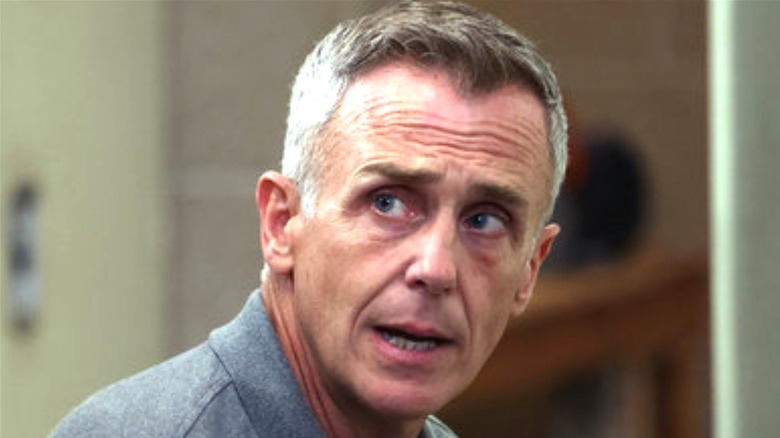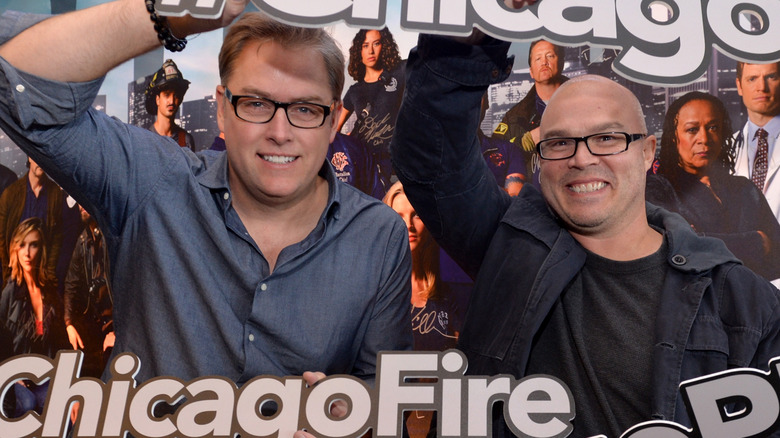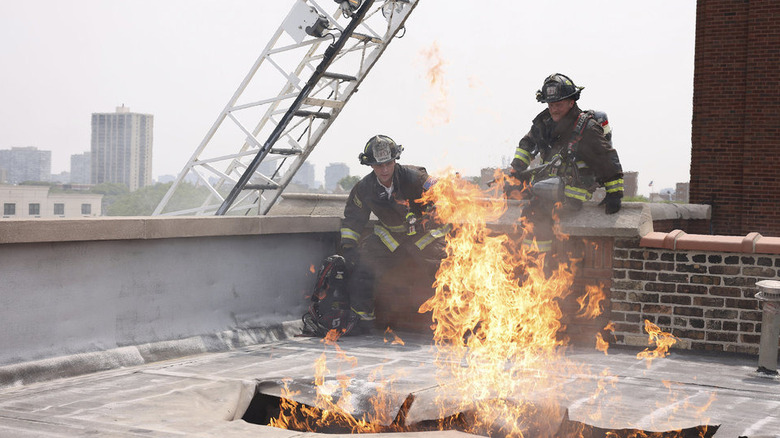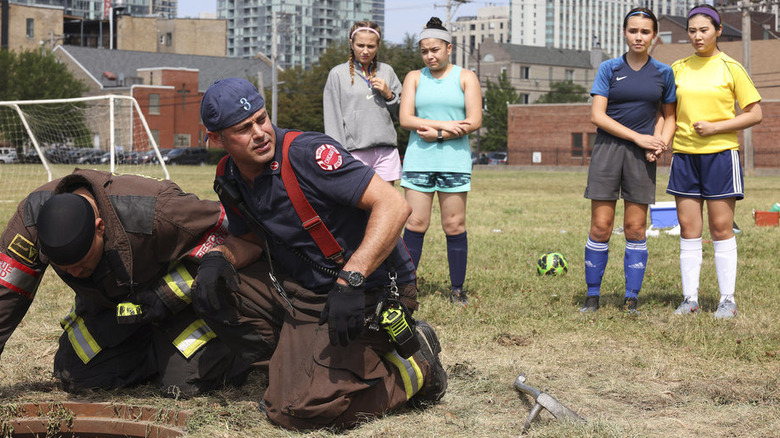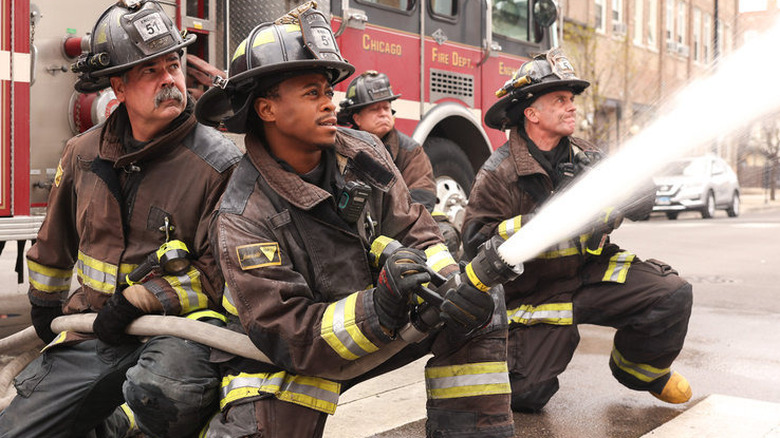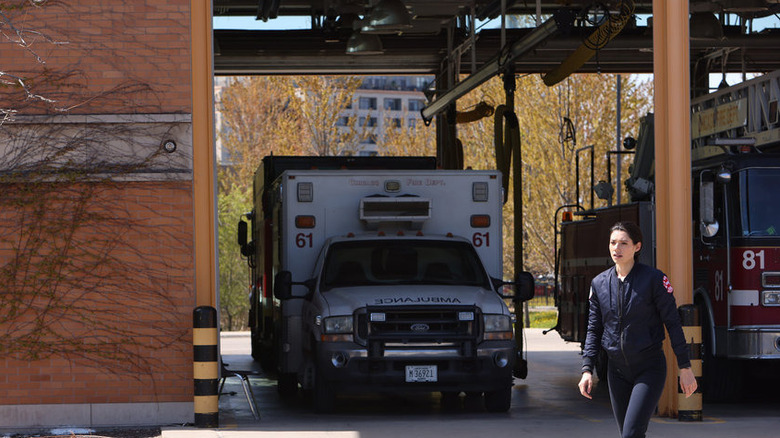The Untold Truth Of Chicago Fire
Providing the igniting spark for what would expand into the "One Chicago" universe of shows, the debut episode of "Chicago Fire" aired on NBC on October 10, 2012. The series was inspired by Dick Wolf's perception that network TV lacked a truly authentic show that explored both the public and private sides of life as experienced by urban firefighters. In that regard, while the new show would showcase the peril and drama of firefighters facing death on regular basis, Wolf also wanted equal time spent detailing the conflicts in his characters' personal lives. Commenting to the Los Angeles Times about how this dual focus differentiated "Chicago Fire" from the other first responder shows airing at the time, Wolf said, "This is not a procedural. It's a character drama with action."
The truth is, "Chicago Fire" immediately scored with audiences not only for its harrowing scenes of characters in life-threatening jeopardy, but also won over viewers with its relatable portrayal of those same public servants blowing off steam or dealing with romantic meltdowns (via the Chicago Tribune). Speaking to The Hollywood Reporter, Wolf explained his approach to creating appealing, network-friendly entertainment for audiences by comparing Wolf Productions to a couple of well-known carmakers, saying, "The wonderful thing about the company is, we don't make Ferraris. We make Mercedes S-class sedans. They're black. They're not flashy. But they run for hundreds of thousands of miles. That's what they're designed to do."
With literally hundreds of episodes, if not miles, in the rear-view mirror, here are a few fascinating, untold truths about "Chicago Fire" that fans may have overlooked.
The first writers on the show were feature film pros, not TV scribes
When initially envisioning the look and feel of "Chicago Fire," Dick Wolf decided that creative elements from the world of feature filmmaking could be employed to reinforce the series' dynamic energy and high production values. Accordingly, rather than relying on writers with episodic TV scriptwriting experience, he tapped veteran screenwriters Michael Brandt and Derek Haas to craft the pilot episode and set the general tone for the series. As co-writers on movies including "2 Fast 2 Furious," "3:10 to Yuma," and "Wanted," (per The Hollywood Reporter), the writing duo had exactly the sort of big-screen sensibilities that Wolf was looking for.
Discussing the show's inception with TVEquals.com, Haas said, "We're movie writers, and we had a call ... Dick Wolf and NBC wanted to do a show about firemen, and every year we've sort of turned down television... But when we heard Dick Wolf's name, the subject matter [of first responders] sounded interesting... and we said, 'What about setting it in Chicago?' since 'Rescue Me' was done in New York and it seemed like it was so intrinsically tied to 9/11, and Chicago itself is a city that was born out of fire and seemed like a good location. So they said yes and we said, 'Well then put us on a plane so we can start rehearsing.'"
Considering the series' enduring popularity, it looks like Wolf made the right call with Haas and Brandt.
Some actors on the series get fired up about stunts
As an action-drama series designed to immerse viewers in a credibly presented world of firefighting exploits and emergency rescue thrills, "Chicago Fire" depends on stunt work that is carefully orchestrated and, despite all the precautions taken, occasionally dangerous. From simulating the life-or-death situations that first responders face when racing into a blazing, multi-story structure fire to extracting victims from precariously balanced vehicle pileups, the stunts on the show are generally executed by professional stunt personnel. These highly trained performers make it their business to safely convince viewers that what's happening on screen is both utterly real and thrillingly hazardous.
That being the case, certain actors on "Chicago Fire" sometimes get the urge to see what it feels like to walk in the shoes of the first responders they portray. Speaking with TV Insider about his work as stunt coordinator on the series, Rick Le Fevour singled out two actors who come to mind in this regard. "I'm really lucky. We have some very good athletes, including Taylor Kinney (Kelly Severide) and Jesse Spencer (Mathew Casey)," he said. "Everyone is gung-ho and they've been trained well in the fire academy. They're confident but not overconfident where they would get hurt."
In fact, when asked about his stunt work by TV Guide, Spencer recalled a scene where he may have been a little too close to the firefighting action. "I did do one today where this door is burning down..." he said. "They covered me in the fireproof gel. I couldn't even feel it. It was crazy. The stuntmen would yell at me, because apparently the fire was licking my face." No doubt, however, fans will be relieved to hear that generally speaking, when the stunts in question are literally too hot to handle, the professionals take over.
Lights, Camera ... Extras!
"Chicago Fire" has a voracious appetite for stand-ins, background actors, and other extras to add that unique element of credibility to the series. Set in the bustling inner city and suburbs of Chicago, any single scene or sequence may require dozens of these hired-on-demand people to bring the urban environment to life. So where does the show come up with this army of bodies to stroll calmly through a mid-town mall, sip beverages at Molly's Pub, or stampede in panic from a burning building? Cue the casting director.
A wide variety of everyday Chicagoans and residents of the surrounding area serve as anonymous extras seen every week on the show (per Loyola University Chicago). Posting calls for extras on social media like Facebook and online showbusiness sites, casting directors list what type of extras "Chicago Fire" is looking for. As noted on the Project Casting site, the storyline of one episode might call specifically for "males and females, 20s to 40s, all ethnicities, to play reporters and camera people," while the following week's call could ask for "real physical therapists" to portray, well, real physical therapists. Another call might request extras to populate a gala fundraising party, which actually sounds like a fun time. So, if you're a "Chicago Fire" enthusiast with a day or evening to spare and eagerness for some low-key, background fame, how much can you make being an extra? The current rate is $12 an hour, but the experience — priceless.
Throwing cold water on spoiler-droppers
Like any network hit series attracting millions of viewers each week, "Chicago Fire" has flocks of eagle-eyed fans who delight in finding and sharing breaking news about the show whenever they can. It's also the case, however, that some of this news can fall squarely into the spoiler category. And the fact is, there are always some fans eager to reveal these tidbits via social media and let the plot-development cat out of the bag. This, of course, is a problem for the show's executives, since maintaining suspense about what happens to which character in a forthcoming episode is a major part of drawing audiences back every Wednesday night.
As it turns out, though, those same series execs are nothing if not resourceful, as "Chicago Fire" co-creator and showrunner Derek Haas has demonstrated in dealing with the issue of spoiler-hunting fans. In an interview with Entertainment Weekly, Haas described how he had gotten into the habit of salting his Twitter feed with carefully placed false flags, leading clue-seeking viewers to think they've hit spoiler-gold when they've actually been handed a convincing, but bogus nothing-burger. He added that his techniques in this regard have included everything from leaking vague or confusing information about a certain favorite character leaving the series to posting misleading photos from the show's set. In the same EW piece, Haas defended his penchant for gently duping these spoiler-droppers, saying, "To me, the only defense is to go on the offense. I try to be honest on the feed, but my honesty is also going to mislead you... If I can add any piece of doubt into whatever is the pervading theory, that's a victory."
The show's firehouse filming location is now a red-hot tourist attraction
Among "Chicago Fire's" most avid fans, it's common knowledge that the show is shot on-location in Chi-town and that the fictional Firehouse 51 is actually a fully operational Chicago fire station (per cheatsheet.com). Officially known as the Engine 18 station, the site provides the series with a sense of authentic, fine-grain realism that would be difficult — and expensive — to replicate on a studio backlot.
It is, however, less well-known is that the location has become a must-see attraction for "Chicago Fire" buffs to visit, both locals and out-of-towners. Confirming this development in an interview with the Chicago Tribune, show consultant and Chicago Fire Department Deputy District Chief Steve Chikerotis reported, "We have people [coming to the station] from all over the world ... We might have 200 to 300 people that are here... I've seen a big increase in the number of tourists coming around."
Posting on Tripadvisor, user npwoods – a way-out-of-town visitor from the United Kingdom — raved about the experience of dropping by the filming location, writing, "We visited the station with our daughter who just turned 10. We surprised her [with] a holiday to Chicago...Arriving at the fire station we were welcomed in by two firefighters that were so warm and friendly and very willing to give us a tour... We got to sit on mouchs couch and buy a souvenir t-shirt. Had to pose in different places to feel part of the show. A big thank you for making our daughters dream come true."
